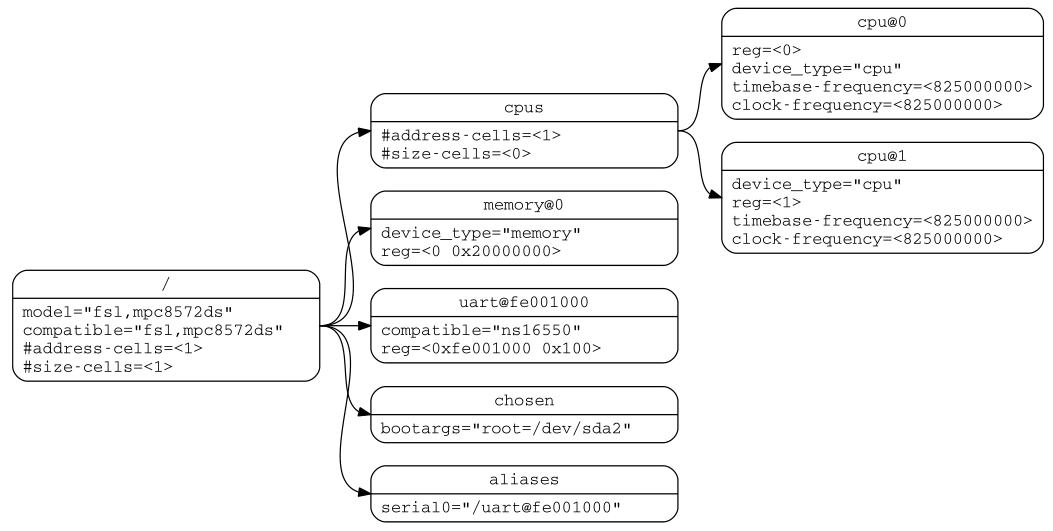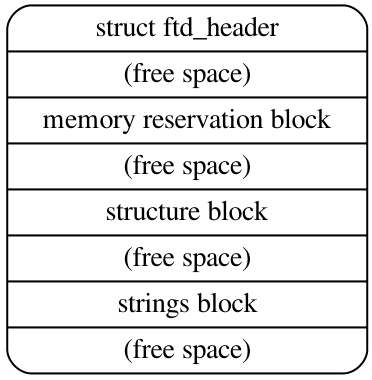
Devicetree(设备树)是用来描述系统硬件信息的树模型,其旨在unify内核。通过bootloader将devicetree的信息传给kernel,然后kernel根据这些设备描述初始化相应的板级驱动,达到一个内核多个平台共享的目的。
Overview
Devicetree主要为描述不可插拔(非动态)设备的板级硬件信息而设计的。它由分层的描述设备信息的节点(node)组成树结构。每个node包含的内容通过property/value对来表示。除root节点外,每个节点都有parent。如图所示:

Node Names
除root节点名用'/'表示外,其余节点都由node-name@unit-address来命名,且同一层级必须是唯一的。
node-name
表示节点名,由1-31个字符组成。如非必须,推荐使用以下通用的node-name: cpu、memory、memory-controller、gpio、serial、watchdog、flash、compact-flash、rtc、interrupt-controller、dma-controller、ethernet、ethernet-phy、TImer、mdio、spi、i2c、usb、can、keyboard、ide、disk、display、sound、atm、cache-controller、crypto、fdc、isa、mouse、nvram、parallel、pc-card、pci、pcie、sata、scsi、vme。
unit-address
表示这个节点所在的bus类型。它必须和节点中reg属性的第一个地址一致。如果这个节点没有reg属性,则不需“@unit-address”。
Path Names
表示一个节点的完整路径(full path)。型如:
/node-name-1/node-name-2/node-name-N
ProperTIes
每个节点包含的主要内容就是这个所描述的设备的属性信息,由name和value组成:
Property Names
1-31个字符,可包含字母、数字、及‘,’,‘.’,‘_’,‘+’,‘?’,‘#’。
Property Values
ValueDescripTIonempty属性值为空,用来表示true-false信息u32/u6432/64位大端字节序的无符号整形,表示时需加<>string,stringlistnull-terminated字符串或其组成的列表
Standard ProperTIes
compatible
Value type: Description: 表示兼容的设备类型,内核据此选择合适的驱动程序。由多个字符串组成,从左到由列出这个设备兼容的驱动(from most specific to most general)。 推荐的格式为:“制造商名,具体型号”。Example: compatible = "fsl,mpc8641-uart", "ns16550"; 内核先搜索支持“fsl,mpc8641-uart”的驱动,如未找到,则搜索支持更通用的“ns16550”设备类型的驱动。
model
Value type: Description: 表明设备型号。 推荐的格式为:“制造商名,具体型号”。Example: model = "fsl,MPC8349EMITX";
phandle
Value type: Description: 用一个树内唯一的数字标识所在的这个节点,其他节点可以直接通过这个数字标识来引用这个节点。Example: pic@10000000 { phandle = <1>; interrupt-controller; }; interrupt-parent = <1>;
status
Value type: Description: 表示设备的可用状态: "okay" -> 设备可用 "disabled" -> 目前不可用,但以后可能会可用 "fail" -> 不可用。出现严重问题,得修一下 "fail-sss" -> 不可用。出现严重问题,得修一下。sss指明错误类型。
#address-cells and #size-cells
Value type: Description: 在拥有子节点的节点中使用,来描述它的字节点的地址分配问题。即分别表示子节点中使用多少个u32大小的cell来编码reg属性中的address域和size域。 这两个属性不会继承,必须明确指出。如未指出,默认#address-cells=2,#size-cells=1。Example: soc { #address-cells = <1>; #size-cells = <1>; serial { reg = <0x4600 0x100>; }; };
reg
Value type: encoded as an arbitraty number of (address, length) pairs.Description: 描述该设备在parent bus定义的地址空间中的地址资源分配。Example: reg = <0x3000 0x20 0xFE00 0x100>; a 32-byte block at offset 0x3000 and a 256-byte block at offset 0xFE00。
virtual-reg
Value type: Description: 表示映射到reg第一个物理地址对应的effective address。使bootloader能够提供给内核它所建立的virtual-to-physical mappings。
ranges
Value type: or encoded as an arbitrary number of (child-bus-address,parent-bus-address, length) triplets.Description: 提供了子地址空间与父地址空间的映射关系,如果值为空则父子地址相等,无需转换。Example: soc { compatible = "simple-bus"; #address-cells = <1>; #size-cells = <1>; ranges = <0x0 0xe0000000 0x00100000>; serial { compatible = "ns16550"; reg = <0x4600 0x100>; }; }; 将子节点serial的0x0地址映射到父节点soc的0xe0000000,映射长度为0x100000。此时reg的实际物理地址就为0xe0004600。
dma-ranges
Value type:
Interrupts
描述中断的属性有4个:
interrupt-controller
一个空的属性用来指示这个节点设备是接收中断信号的控制器。
#interrupt-cells
这是上面所说中断控制器中的一个属性,用来描述需要用多少个cell来描述这个中断控制器的interrupt specifier(类似#address-cells和#size-cells)。
interrupt-parent
常出现在根节点的一个属性,它的属性值是指向interrupt-controller的一个phandle。可从parent继承。
interrupts
包含interrupt specifiers列表,每一个specifier表示一个中断输出信号。
Example
/ { interrupt-parent = <&intc>; intc: interrupt-controller@10140000 { compatible = "arm,pl190"; reg = <0x10140000 0x1000 >; interrupt-controller; #interrupt-cells = <2>; }; serial@101f0000 { interrupts = < 1 0 >; };};
Base Device Node Types
所有的设备树都必须有一个root节点,且root节点下必须包含一个cpus节点和至少一个memory节点。
root node
root节点须包含 #address-cells、#size-cells、model、compatible等属性。
/cpus node
是cpu子节点的父节点容器。须包含 #address-cells、#size-cells属性。
/cpus/cpu* node
是描述系统cpu的节点。
/memory node
描述系统物理内存的layout。须包含reg节点。Example:假如一个64位系统有如下两块物理内存:- RAM: starting address 0x0, length 0x80000000 (2GB)- RAM: starting address 0x100000000, length 0x100000000 (4GB)则我们可以有下面两种描述方法(#address-cells = <2> and #size-cells =<2>):Example #1 memory@0 { reg = <0x000000000 0x00000000 0x00000000 0x80000000 0x000000001 0x00000000 0x00000001 0x00000000>; };Example #2 memory@0 { reg = <0x000000000 0x00000000 0x00000000 0x80000000>; }; memory@100000000 { reg = <0x000000001 0x00000000 0x00000001 0x00000000>; };
/chosen node
根节点下的一个子节点,不是描述设备而是描述运行时参数。常用来给内核传递bootargs:chosen { bootargs = "root=/dev/nfs rw nfsroot=192.168.1.1 console=ttyS0,115200";};
/aliases node
由1-31个字母、数字或下划线组成的设备节点full path的别名。它的值是节点的全路径,因此最终会被编码成字符串。aliases { serial0 = "/simple-bus@fe000000/serial@llc500";}
Device Bindings
更多具体设备具体类别的描述信息:内核源代码/Documentation/devicetree/bindings。
DTS是描述devicetree的源文本文件,它通过内核中的DTC(Devicetree Compiler)编译后生成相应平台可烧写的二进制DTB。
Devicetree Blob (DTB) Structure
DTB又称Flattened Devicetree(FDT),在内存中的结构如下图所示:

Header
大端字节序结构体:
struct fdt_header { uint32_t magic; /* contain the value 0xd00dfeed (big-endian) */ uint32_t totalsize; /* the total size of the devicetree data structure */ uint32_t off_dt_struct; /* offset in bytes of the structure block */ uint32_t off_dt_strings; /* offset in bytes of the strings block */ uint32_t off_mem_rsvmap; /* offset in bytes of the memory reservation block */ uint32_t version; /* the version of the devicetree data structure */ uint32_t last_comp_version; /* the lowest version used is backwards compatible */ uint32_t boot_cpuid_phys; /* the physical ID of the system’s boot CPU */ uint32_t size_dt_strings; /* the length in bytes of the strings block */ uint32_t size_dt_struct; /* the length in bytes of the structure block */};
Memory Reservation Block
Purpose
为系统保留一些特殊用途的memory。这些保留内存不会进入内存管理系统。
Format
struct fdt_reserve_entry { uint64_t address; uint64_t size;};
Structure Block
Devicetree结构体存放的位置。由一行行“token+内容”片段线性组成。
token
每一行内容都由一个32位的整形token起始。token指明了其后内容的属性及格式。共有以下5种token:
tokenDescriptionFDT_BEGIN_NODE (0x00000001)节点起始,其后内容为节点名FDT_END_NODE (0x00000002)节点结束FDT_PROP (0x00000003)描述属性FDT_NOP (0x00000004)nothing,devicetree解析器忽略它FDT_END (0x00000009)block结束
tree structure
(optionally) any number of FDT_NOP tokens
FDT_BEGIN_NODE
The node’s name as a null-terminated string
[zeroed padding bytes to align to a 4-byte boundary]
For each property of the node:
(optionally) any number of FDT_NOP tokens
FDT_PROP token
property information
[zeroed padding bytes to align to a 4-byte boundary]
Representations of all child nodes in this format
(optionally) any number of FDT_NOP tokens
FDT_END_NODE token
Devicetree Source (DTS) Format
Node and property definitions
[label:] node-name[@unit-address] { [properties definitions] [child nodes] };
File layout
Version 1 DTS files have the overall layout:
/dts-v1/; /* dts 版本1 */[memory reservations] /* DTB中内存保留表的入口 */ / { [property definitions] [child nodes] };
欢迎分享,转载请注明来源:内存溢出

 微信扫一扫
微信扫一扫
 支付宝扫一扫
支付宝扫一扫
评论列表(0条)